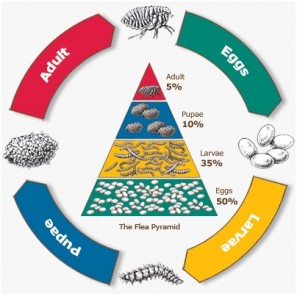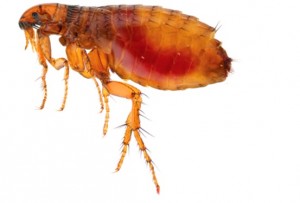No owner wants to think that their pet has fleas, but unfortunately here on the West Coast it rarely gets cold enough to rid us of these little pests. Fleas thrive in humid mild temperatures exactly like the one we live in. In a whopping 95% of cases adult fleas aren’t even seen! Some signs of fleas are scratching, black pepper like debris on the skin known as flea dirt, chewing, licking, rubbing, rolling, and head shaking. The only way to be sure your pets doesn’t have fleas is to take preventative measures.
Flea Life cycle
Fleas can jump onto your pet from the outdoors or from another pet. Once they have fed they will begin to breed. Fleas can lay up to 20 eggs at a time and a female flea can lay about 5000 eggs over a lifetime. These eggs don’t stay on your pet, but roll off and drop to the floor. There they can be transferred to shoes, pants, socks, and other pets to be transported around. Eggs will hatch within two weeks and become larvae. After 1 or 2 weeks the larvae weaves a cocoon around itself and starts the pupae stage. This stage is the tough one. Fleas can stay in their cocoon for several months waiting for ideal conditions. Once the flea emerges it must feed within a few days to survive.
If you do discover that your pets has fleas… well then it’s time to disrupt the cycle. “Disrupting the cycle” is a phrase you hear a lot at animal hospitals. This is the best way to end the cycle of fleas. Ideally, choose a flea treatment that targets at least two stages of the flea life cycle. If you have other pets in the house, everyone will be needed to be given a flea treatment. Even after applying the medication you are likely to see adult fleas as the pupae around the house hatch. Vacuuming every day is also recommended as flea eggs are everywhere. And not only vacuuming, but a thorough vacuum. This includes couches, pillows, under cabinets, and around baseboards. Even wooden floors aren’t safe! Flea eggs can stay tucked in the cracks between the boards. Empty your vacuum outside of the house in order to prevent any eggs from remaining in the home. Wash all of the bedding that your pet sleeps in (including yours!) in hot water twice a week. Finally you can use Siphotrol spray around the house to help kill any adult fleas left. Again, year round prevention is the only way to be sure that your pet does not have fleas.
There are many flea prevention products to choose from; some are topical (applied to the skin) and some are administered orally (given by mouth). At Menzies we carry a variety of products for our clients to choose from including Revolution, Advantage, Advantage Multi, Bravecto, Comfortis, Trifexis, and Capstar to name a few.
- Revolution – A topical non-chemical that kills fleas, ticks, heartworm, and other worms. An ideal product for owners with young children or multiple pets. Revolution is completely safe, even if accidentally ingested. A prescription medication, we need to have seen your pet in the last 12 months to sell this product to you.
- Advantage – A pesticide that kills fleas before they bite. Advantage is the only non-prescription flea medication that we carry. It kills adult fleas, eggs, and larvae. Advantage is applied topically to the back of the neck.
- Advantage Multi – A pesticide that kills fleas and worms. It kills adult fleas, worms, and mites.
- Bravecto – A chewy tablet that kills adult fleas and ticks. This is the only product that lasts for 3 months with one dose.
- Comfortis – A chewable tablet that kills adult fleas and eggs.
- Trifexis – A chewable tablet that kills Adult fleas and intestinal worms. Also prevents heartworm.
- Capstar – A small pill that will kill fleas within minutes of ingestion. Unfortunately it only lasts for 24 hours, but it’s excellent for ridding your pet of those live adult fleas that are biting.
Feel free to give us a call anytime to discuss the flea prevention medication that will be best for your pet and your home!






